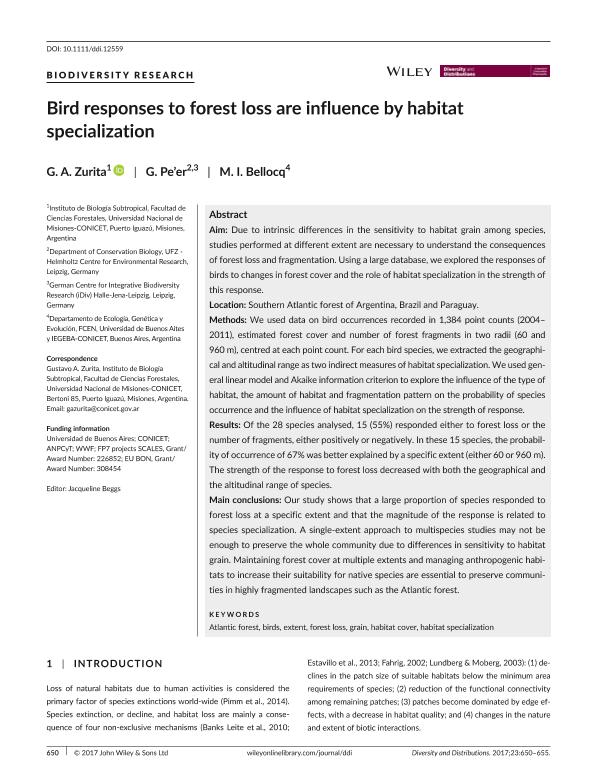Mostrar el registro sencillo del ítem
dc.contributor.author
Zurita, Gustavo Andres

dc.contributor.author
Pe'er, G.
dc.contributor.author
Bellocq, Maria Isabel

dc.date.available
2018-05-21T20:30:34Z
dc.date.issued
2017-02
dc.identifier.citation
Zurita, Gustavo Andres; Pe'er, G.; Bellocq, Maria Isabel; Bird responses to forest loss: the influence of habitat specialization; Wiley Blackwell Publishing, Inc; Diversity and Distributions; 23; 6; 2-2017; 650-655
dc.identifier.issn
1366-9516
dc.identifier.uri
http://hdl.handle.net/11336/45828
dc.description.abstract
Aim: Due to intrinsic differences in the sensitivity to habitat grain among species, studies performed at different extent are necessary to understand the consequences of forest loss and fragmentation. Using a large database, we explored the responses of birds to changes in forest cover and the role of habitat specialization in the strength of this response. Location: Southern Atlantic forest of Argentina, Brazil and Paraguay. Methods: We used data on bird occurrences recorded in 1,384 point counts (2004?2011), estimated forest cover and number of forest fragments in two radii (60 and 960 m), centred at each point count. For each bird species, we extracted the geographical and altitudinal range as two indirect measures of habitat specialization. We used general linear model and Akaike information criterion to explore the influence of the type of habitat, the amount of habitat and fragmentation pattern on the probability of species occurrence and the influence of habitat specialization on the strength of response. Results: Of the 28 species analysed, 15 (55%) responded either to forest loss or the number of fragments, either positively or negatively. In these 15 species, the probability of occurrence of 67% was better explained by a specific extent (either 60 or 960 m). The strength of the response to forest loss decreased with both the geographical and the altitudinal range of species. Main conclusions: Our study shows that a large proportion of species responded to forest loss at a specific extent and that the magnitude of the response is related to species specialization. A single-extent approach to multispecies studies may not be enough to preserve the whole community due to differences in sensitivity to habitat grain. Maintaining forest cover at multiple extents and managing anthropogenic habitats to increase their suitability for native species are essential to preserve communities in highly fragmented landscapes such as the Atlantic forest.
dc.format
application/pdf
dc.language.iso
eng
dc.publisher
Wiley Blackwell Publishing, Inc

dc.rights
info:eu-repo/semantics/openAccess
dc.rights.uri
https://creativecommons.org/licenses/by-nc-sa/2.5/ar/
dc.subject
Birds
dc.subject
Conservation
dc.subject
Habitat Loss
dc.subject
Subtropical Forest
dc.subject.classification
Otras Ciencias Biológicas

dc.subject.classification
Ciencias Biológicas

dc.subject.classification
CIENCIAS NATURALES Y EXACTAS

dc.title
Bird responses to forest loss: the influence of habitat specialization
dc.type
info:eu-repo/semantics/article
dc.type
info:ar-repo/semantics/artículo
dc.type
info:eu-repo/semantics/publishedVersion
dc.date.updated
2018-05-16T14:45:36Z
dc.identifier.eissn
1472-4642
dc.journal.volume
23
dc.journal.number
6
dc.journal.pagination
650-655
dc.journal.pais
Reino Unido

dc.journal.ciudad
Londres
dc.description.fil
Fil: Zurita, Gustavo Andres. Consejo Nacional de Investigaciones Científicas y Técnicas. Centro Científico Tecnológico Conicet - Nordeste. Instituto de Biología Subtropical. Instituto de Biología Subtropical - Nodo Puerto Iguazú | Universidad Nacional de Misiones. Instituto de Biología Subtropical. Instituto de Biología Subtropical - Nodo Puerto Iguazú; Argentina
dc.description.fil
Fil: Pe'er, G.. Helmholtz Centre for Environmental Research. Department of Conservation Biology; Alemania
dc.description.fil
Fil: Bellocq, Maria Isabel. Consejo Nacional de Investigaciones Científicas y Técnicas. Oficina de Coordinación Administrativa Ciudad Universitaria. Instituto de Ecología, Genética y Evolución de Buenos Aires. Universidad de Buenos Aires. Facultad de Ciencias Exactas y Naturales. Instituto de Ecología, Genética y Evolución de Buenos Aires; Argentina
dc.journal.title
Diversity and Distributions

dc.relation.alternativeid
info:eu-repo/semantics/altIdentifier/doi/http://dx.doi.org/10.1111/ddi.12559
dc.relation.alternativeid
info:eu-repo/semantics/altIdentifier/url/https://onlinelibrary.wiley.com/doi/abs/10.1111/ddi.12559
Archivos asociados
